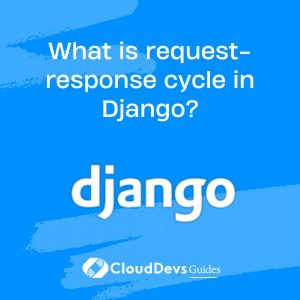What is request-response cycle in Django?
Django’s request-response cycle is a fundamental concept that outlines how the Django web framework processes incoming HTTP requests and generates corresponding HTTP responses. This cycle is the core mechanism through which Django handles client interactions and serves web applications. Here’s an explanation of Django’s request-response cycle:
- Client Request: The cycle begins when a client (usually a web browser) sends an HTTP request to a Django-powered web server. The request includes important information such as the requested URL, HTTP method (e.g., GET, POST), headers, and any data sent in the request body (e.g., form data).
- URL Routing: Django’s URL dispatcher, configured in your project’s `urls.py` file, plays a central role. It examines the incoming request’s URL to determine which view function should handle the request. The URL dispatcher uses regular expressions or path converters to map URLs to view functions.
- View Function Processing: Once the URL dispatcher identifies the appropriate view function, it calls that function, passing the HTTP request as its argument. The view function contains the application’s logic, processing the request, interacting with models and databases, and preparing data for the response.
- Response Preparation: After processing, the view function constructs an HTTP response object. This response object includes the content to be sent back to the client, such as HTML content, JSON data, or binary files. You can also set response headers, cookies, and status codes within the response object.
- Middleware Execution: Before the response is sent back to the client, Django’s middleware is executed. Middleware are functions or classes that can perform actions such as authentication, request/response modification, logging, and more. Middleware can either process the request before it reaches the view function or the response before it leaves the server.
- Sending the Response: Finally, the HTTP response is sent back to the client over the network. The client’s web browser processes the response, rendering HTML content, executing JavaScript, and displaying the web page. If the response includes data, the client may also use that data for further interaction or rendering.
- Repeat or Terminate: The request-response cycle repeats whenever the client interacts with the web application by sending additional requests. The cycle can continue as long as the client interacts with the application. When the client no longer needs to communicate with the server, the request-response cycle for that interaction terminates.
Django’s request-response cycle is the foundational process that drives the interaction between clients and web applications built using Django. It orchestrates the handling of incoming requests, routing them to the appropriate view functions, processing and preparing responses, and ultimately sending those responses back to the client, making it a fundamental concept to understand when working with Django






